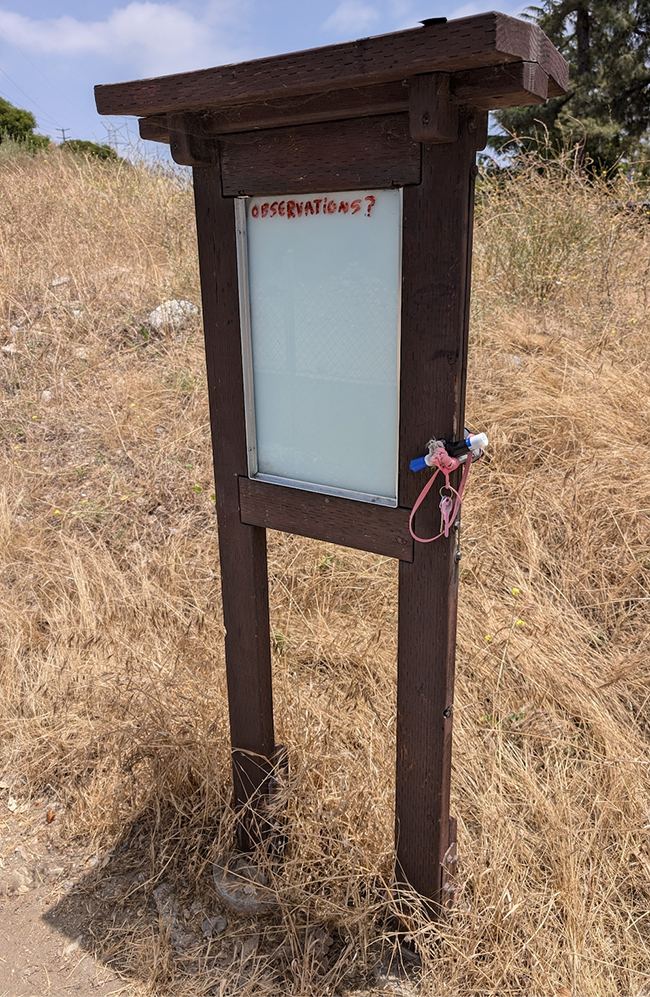Redford Conservancy opens its doors to first batch of students

With a focus equally rooted in history and the future, Pitzer College opened the Robert Redford Nature Conservancy for Southern California Sustainability to its first round of students this semester.
The conservancy, which is located on a 12-acre parcel near the Bernard Biological Field Station (BFS), is now an integral component of the environmental analysis (EA) programs at the Claremont Colleges by offering additional field-based educational opportunities to all students.
Programming goes beyond biology and science, introducing a cross-disciplinary approach to natural sciences education with the combined Pitzer art and EA major, as well as coursework dedicated to environmental sustainability, policy and social responsibility.
“We look at it as embodied learning,” said Brinda Sarathy, conservancy director. “The conservancy takes a much more holistic approach through art, policy and science.”
Just as she joined Pitzer in 2015, the college began work on planning documents for the conservancy. This process would take about six months, Ms. Sa
With a $10 million gift from Hyatt hotel heir Nicholas Pritzker and his wife Susan—along with actor Robert Redford lending his name—the $8 million infirmary renovation breathed new life into the formerly boarded up historic building.
Pasadena architects Marston and Maybury, who also conceived the Padua Hills Theatre and “The Coop” at Pomona College, among other southern California landmarks, designed it in the 1930s.
The infirmary was used as a hospital or recovery facility by Pomona College “pre-antibiotics,” Ms. Sarathy said. The 8000-square-foot building offered 20 beds for all of the Claremont Colleges until the 1960s, when stricter mandates for earthquake codes were enacted.
By the early 1970s, the building was nearly destroyed after it was firebombed during a student protest. The city of Claremont and the fire department condemned the infirmary in the 1980s.
As John Neiuber noted in his column “From the Files of Claremont Heritage,” the infirmary was a gift of Mr. and Mrs. Hiram T. Cleaver in honor of Colonel Seeley W. Mudd, a trustee of Pomona College who served on the Committee on Future Organization, which formed the Claremont Colleges in 1925.
A permit to demolish the building was denied, and it has sat unused and boarded up since the late 1990s. Although a massive undertaking, Ms. Sarathy describes the year-long renovation as “low impact.”
“We didn’t repaint it and even some remnants from the 1973 fire remain,” she said.
The hospital bed areas have been transformed to classrooms, and the once dark and dingy basement now offers a classroom for about 40 students as well as a meeting room. To cushion sound, acoustic panels made from shredded birch and aspen bark adorn the classroom ceilings.
When work began, construction crews found two large bee hives trapped between casement windows and screens. The hives were kept and hung as art, greeting visitors as they walk through the main entrance.
“The queen was captured,” Ms. Sarathy said. “We took her to the central valley orchards.”
Even the finishes—designers chose a ceramic floor tile resembling honeycomb—were selected with a purpose.
“There are multiple ways this building speaks to its past,” Ms. Sarathy said.
Sustainability and reuse guided each step of the restoration, said Warren Biggins, sustainability manager at Pitzer College.
“The original tiles on the roof were taken off, examined and put back on,” he said. “And any replacement tiles we needed were bought from the same local factory who made the originals.”
Two outdoor classrooms structures support solar panel arrays produce “more electricity than the building consumes,” Mr. Biggins said, adding that Pitzer was committed to making it a net-zero energy facility. Students can conduct field-based research and continue their studies under one of the canopies with laptops and microscopes.
Students from any of the Colleges can study at the center; offerings include courses for majors in field-based natural science and environmental analysis, public outreach, art and environmental analysis, interdisciplinary sustainability or collaborations with Indigenous communities.
This semester, Ms. Sarathy is teaching “Hustle and Flow,” a course that explores the history and future of California water policies.
In its first semester, the Redford Conservancy introduced eight to 10 courses a week to upward of 100 students. Ms. Sarathy said protecting the surrounding environment while allowing for new visitors is exceedingly important.
“It’s not a park. It’s not a recreation space,” Ms. Sarathy said. “There are active research projects at the Bernard Field Station we are mindful of.”
Only one structure was removed—the nurses quarters that was added in the 1950s. But the original concrete slab now hosts picnic tables for students to work, socialize or eat lunch outdoors.
As far as landscaping, Ms. Sarathy said Pitzer selected not just drought-tolerant plants but avoided non-natives to eliminate any cross-pollination.
“We had native plants germinated at Rancho Santa Ana Botanic Garden and replanted them here,” she said. “We stayed in close conversation with both biologists and the Tongva Elders and many of the plants were planned in relation to their culture practices as well.”
The conservancy will host an art exhibit opening, “Ephemeral Natures,” on Saturday, April 28 from 1:30 to 3 p.m. Attendees should meet at 1:15 p.m. in the lobby outside the Broad Performance Space at North Mills Avenue to be escorted up to the Redford Conservancy.
To learn more, visit pitzer.edu/redfordconservancy.
—Kathryn Dunn
editor@claremont-courier.com









0 Comments